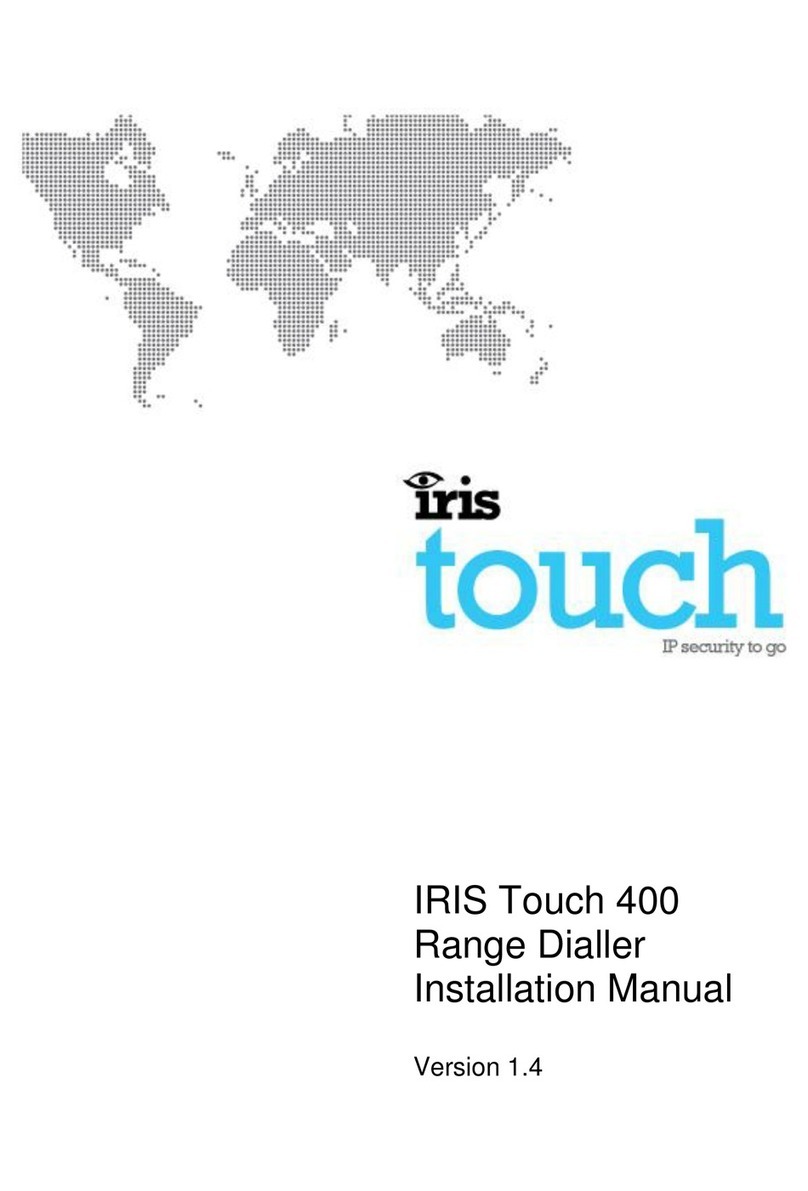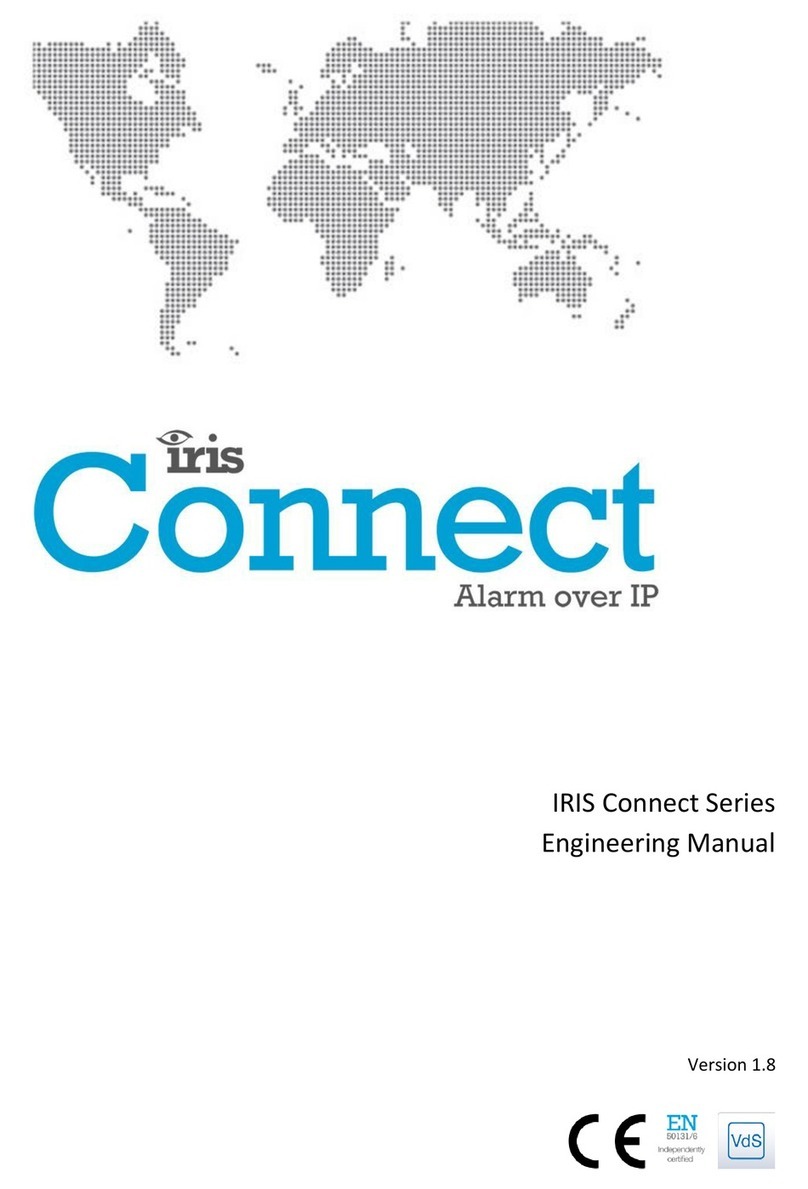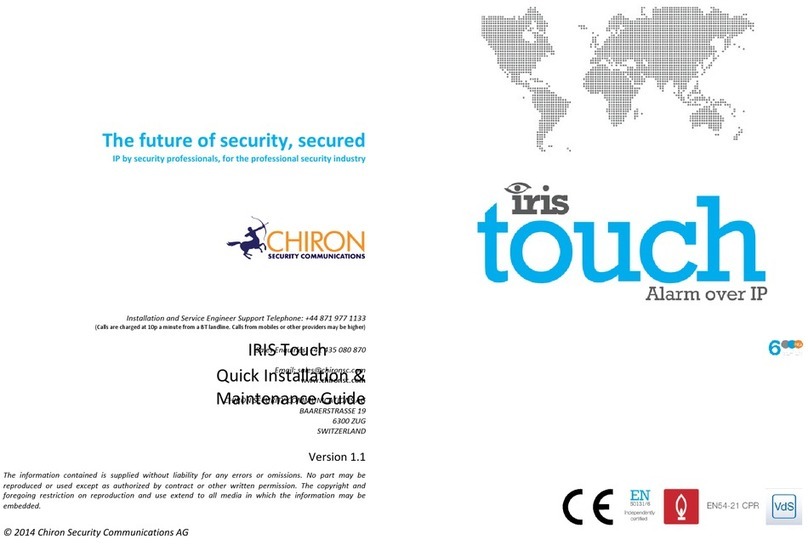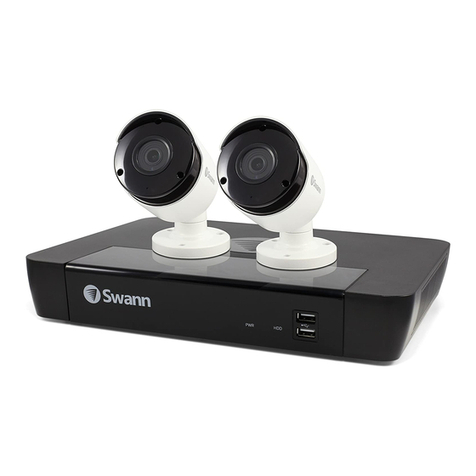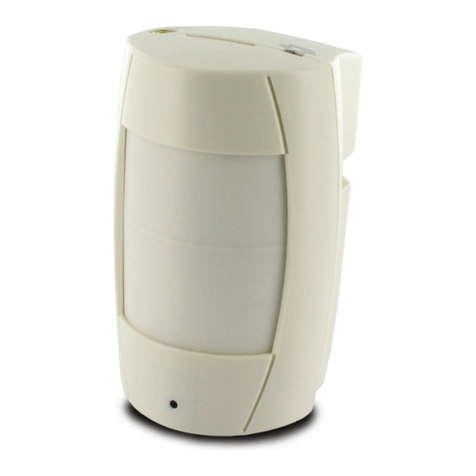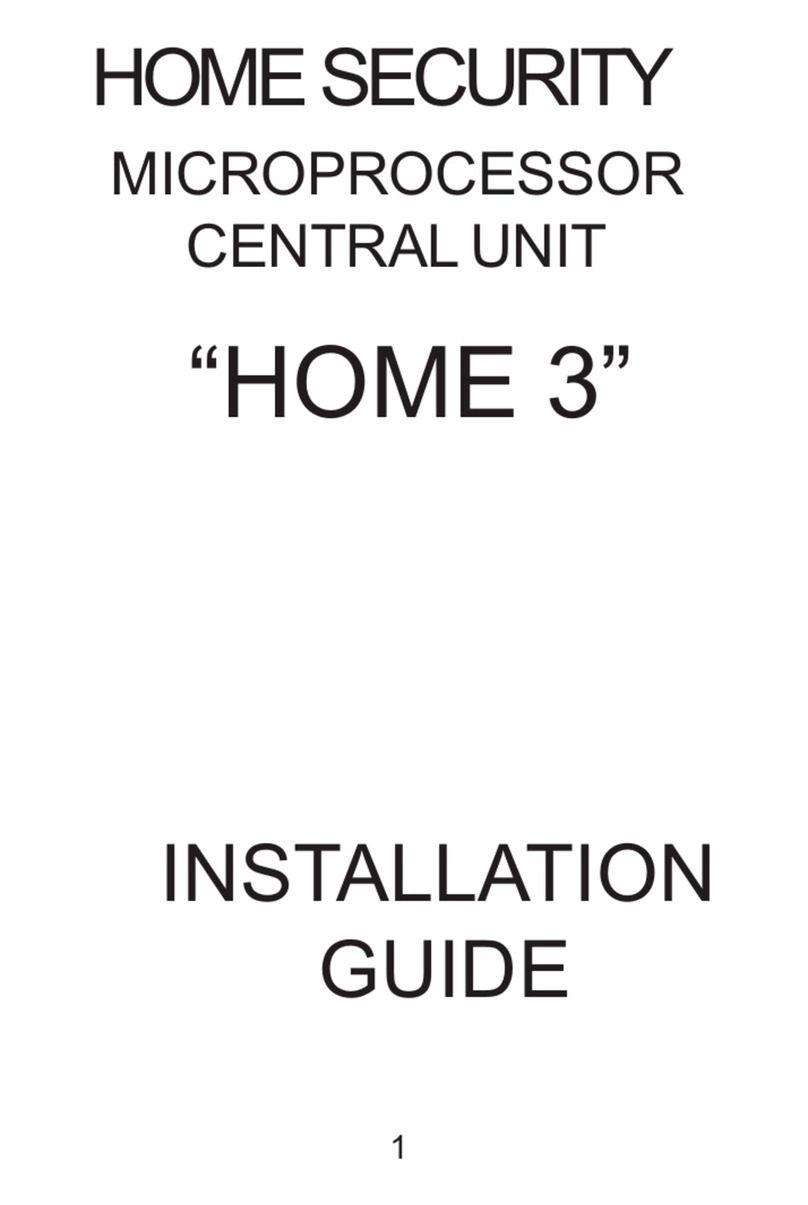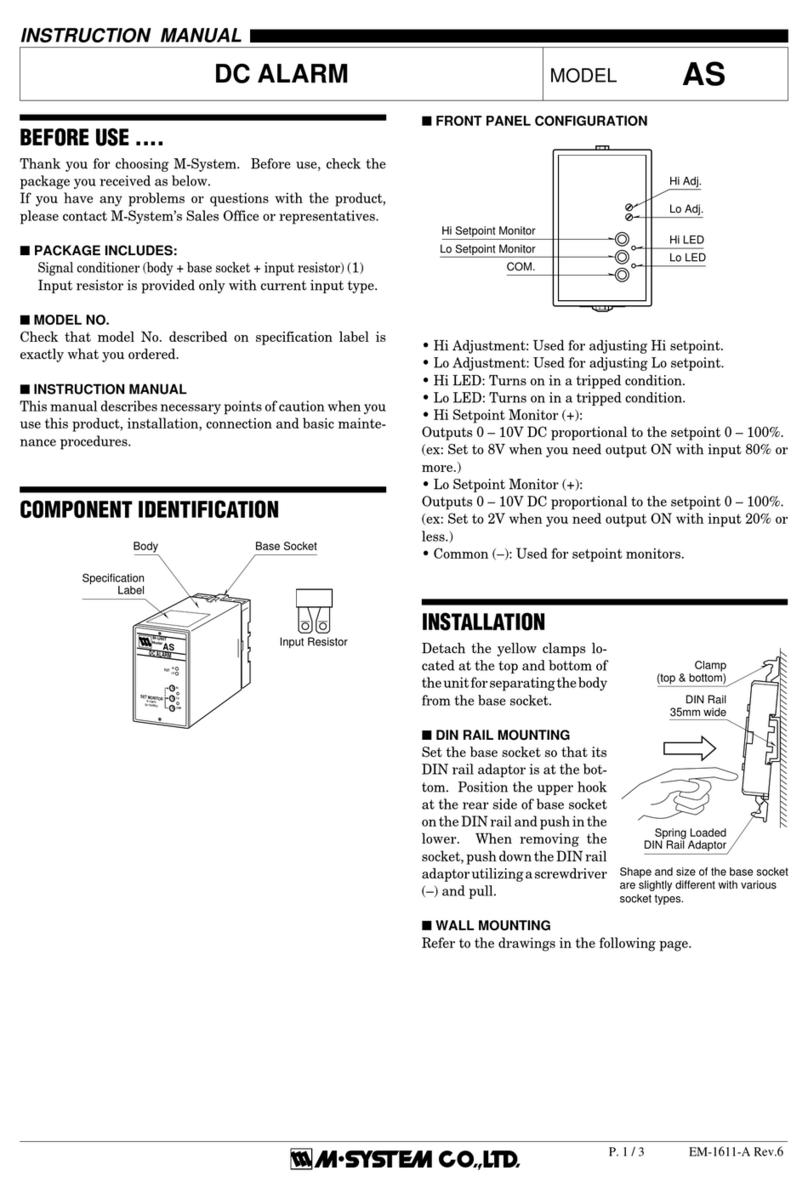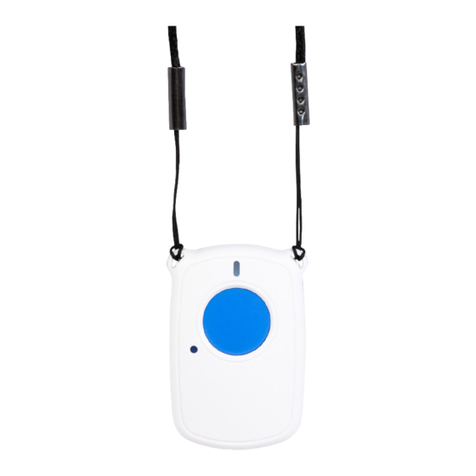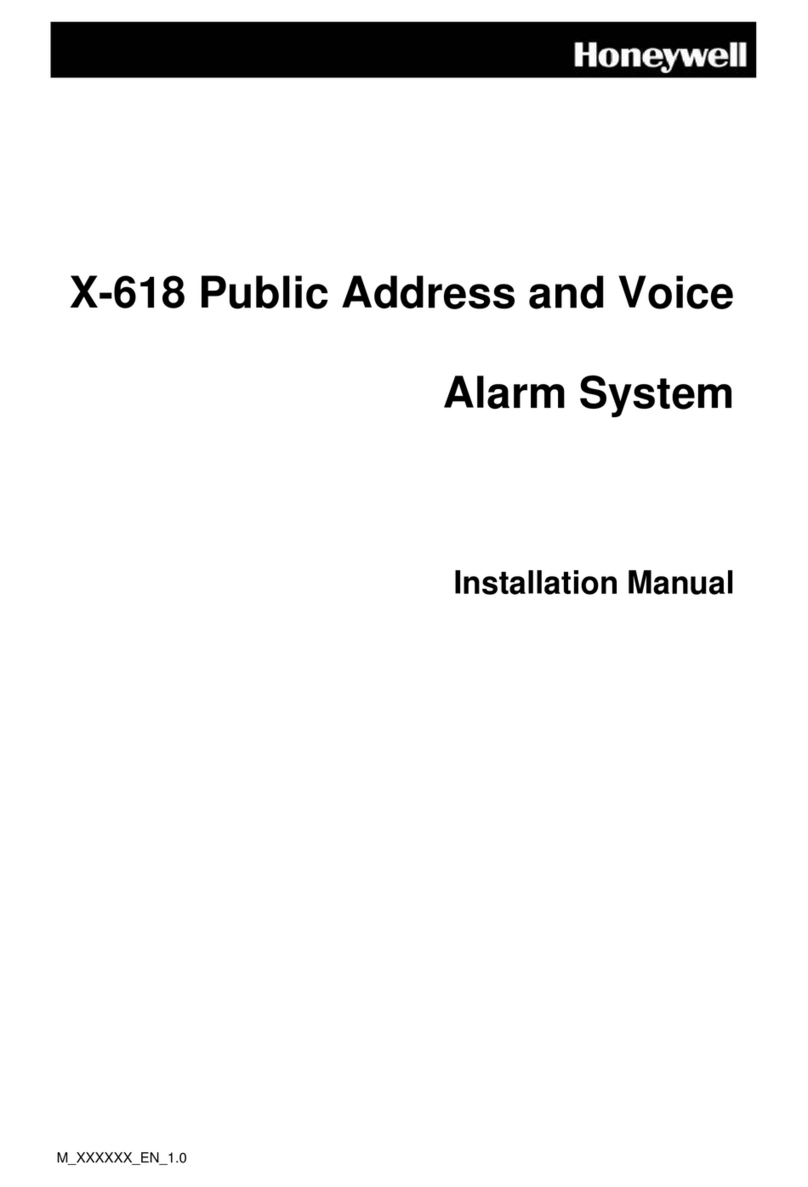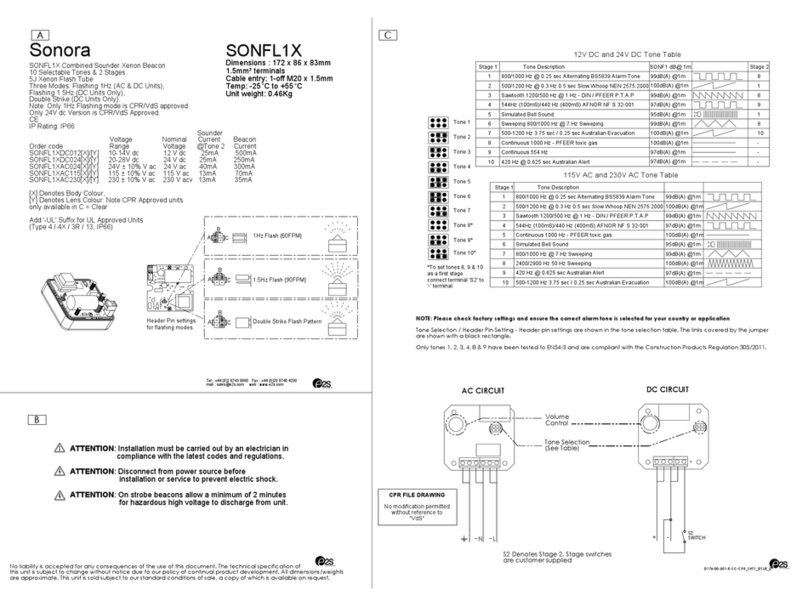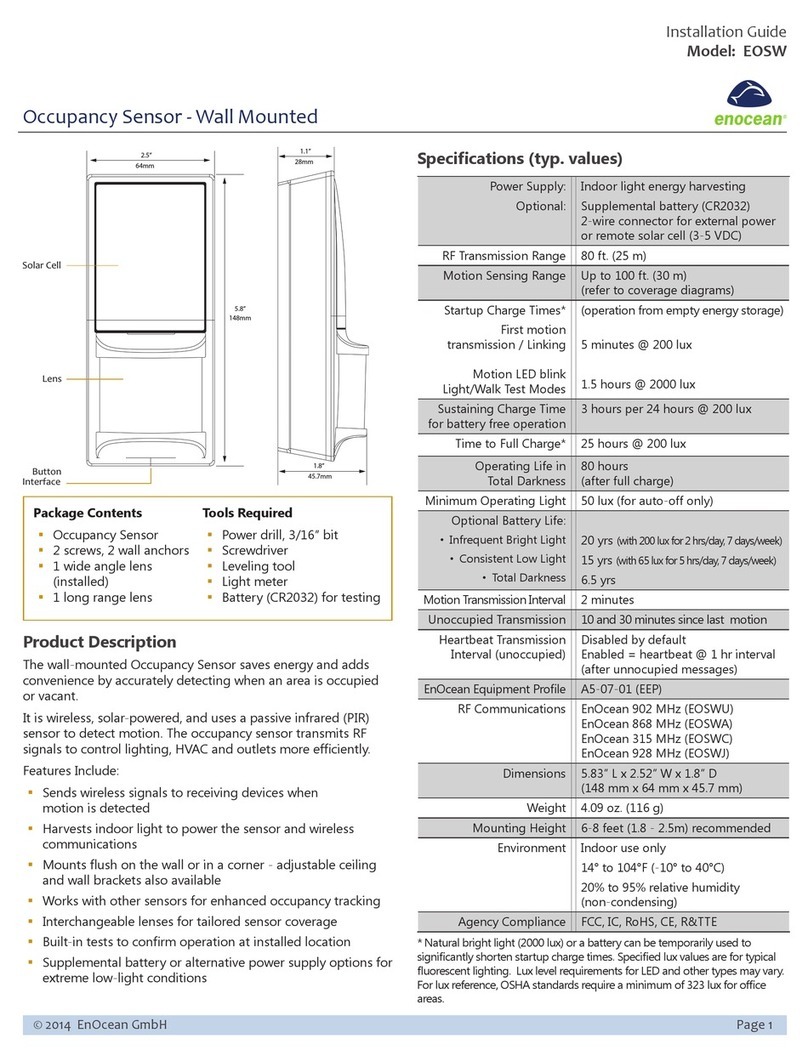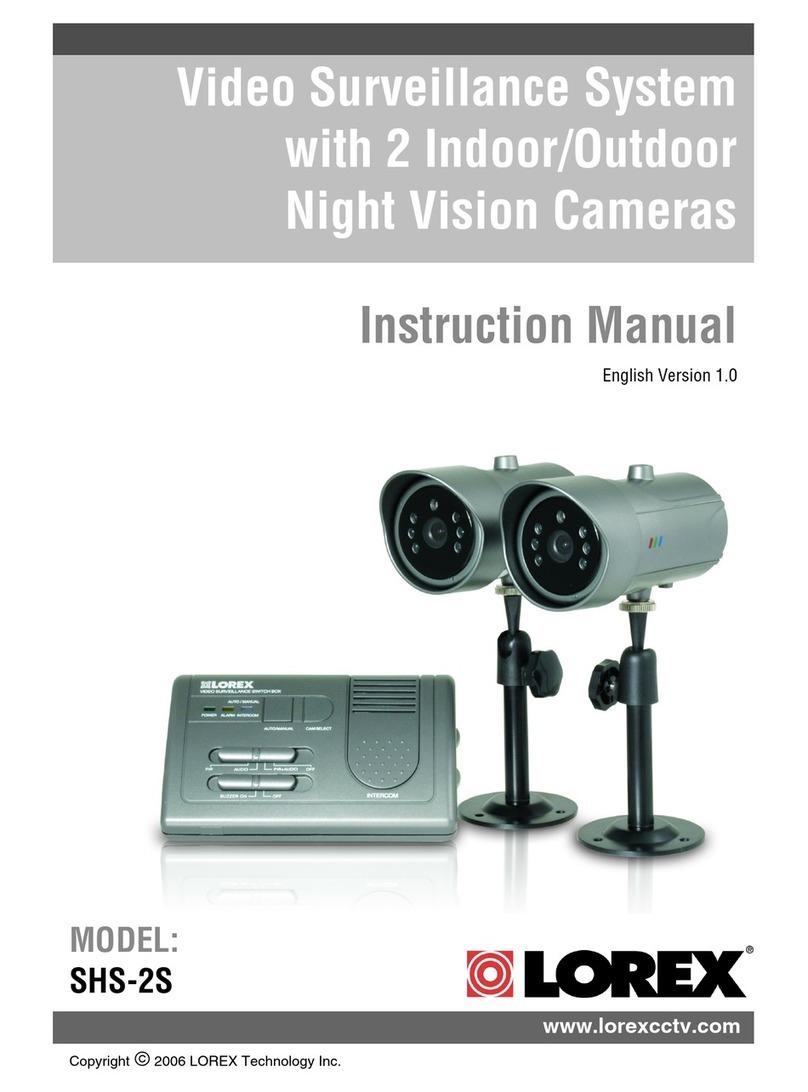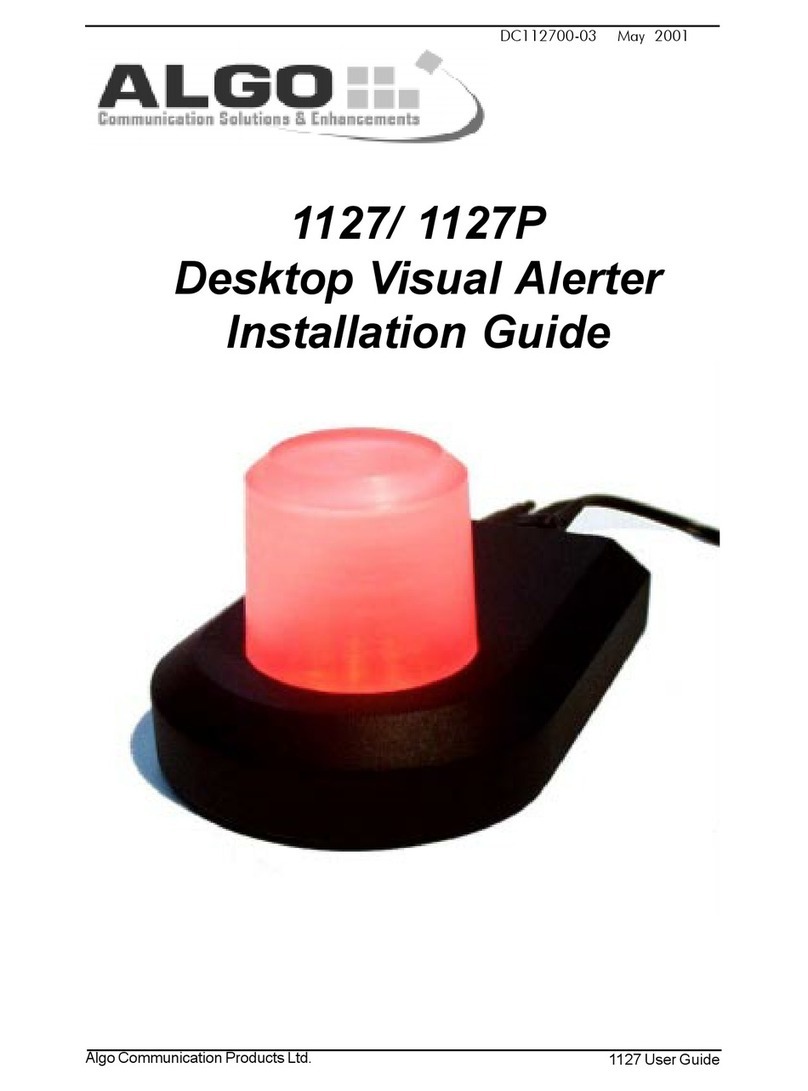Chiron Iris Touch 600NG Installation and operation manual

IRIS Touch
Engineering Manual
Version 1.4

Page 2 of 40 IRIS Touch Engineering Manual Version 1.4
Contents
1. Introduction....................................................................................................................................................... 3
2. IRIS Communication Mechanism (Polling / Alarms) .......................................................................................... 4
3. Product Features ............................................................................................................................................... 5
4. Package Contents .............................................................................................................................................. 6
5. Board Configuration .......................................................................................................................................... 6
6. Before You Start................................................................................................................................................. 7
7. Installing the IRIS Touch Dialler ......................................................................................................................... 8
8. Main menu (Only accessible via USB connection)........................................................................................... 15
9. Trouble report.................................................................................................................................................. 33
10. Installation for EN54-21 Compliant Fire Applications ..................................................................................... 35
11. Maintenance.................................................................................................................................................... 37
12. Specifications................................................................................................................................................... 38

IRIS Touch Engineering Manual Version 1.4 Page 3 of 40
1. Introduction
The IRIS Touch offers cost effective Alarm over IP (AoIP) for the commercial and residential sectors.
All IRIS Touch diallers are certified as suitable for all Grade 4 systems with an Alarm Transmission System (ATS)
configuration up to SP6 for single path, or ATS configuration DP4 for dual path (IRIS Touch 640NG only).
The IRIS Touch is based on Chiron’s successful IRIS Touch range of AoIP diallers with the same hardware and
software used in all IRIS diallers; with the same level of security and features provided to military, governments,
banks and commercial industry markets.
Polling and alarm transmission are performed via the Ethernet or GPRS/3G communication paths (4G and CDMA on
request) to the monitoring centre using the IRIS Secure Apps monitoring software.

Page 4 of 40 IRIS Touch Engineering Manual Version 1.4
2. IRIS Communication Mechanism (Polling / Alarms)
The polling / alarm mechanism used on the Chiron IRIS system is highly secure and flexible, and uses the IRIS Secure
Apps monitoring software (installed at the monitoring centres) with the IRIS Touch diallers.
It has been independently certified as compliant to the highest level of security available –Grade 4, ATS6 - within the
EN50131 standard for alarm systems.
The IRIS system is unique in its ability for the polling frequency to be varied which means that the polling profile can
be adjusted as necessary to take into account the grade of security required and the traffic bandwidth available.
Key features are:
Independently certified as compliant with EN50131-1 Grade 4 ATS configuration SP6 over Ethernet and ATS –
SP5 over GPRS for single path Ethernet and DP4 for dual path communications.
After initial installation all backup or alternate IP address for the Polling engines (main & backup) are
downloaded to the IRIS Touch dialler over the polling communications.
All polling and alarms are authenticated by the receiver (Polling Engine) using the secure and sophisticated
‘Challenge Handshake’ mechanism as used in military and credit card applications. Each remote IRIS dialler
proves its authenticity using a 256 bit security key. A new random number generated by the receiver (Polling
Engine) is used for every poll so it is not possible to substitute the dialler using playback or sequence prediction.
Unlike other systems each dialler can have a unique security key which can be changed at the monitoring centre
any time as required. For additional security the installer never needs to load the key or be aware of what it is.
Also unlike other systems, the polling frequency is not fixed and can be varied by the monitoring centre at any
time, from a period of 10 seconds for high security systems down to once a week for low security systems. This
means that polling rates can be optimised to deliver the grade of service required and minimise the bandwidth
required.
Polling and alarms are carried over the TCP/IP protocol that gives end-to-end error protection. This removes the
possibility with other protocols such as UDP that data packets are lost or re-sequenced in the network leading
to false alarms.
All polling and alarms are outbound from the dialler location to the monitoring centre and do not require the IP
address of the dialler to be known. No special set-up is required at the customer’s router, such as port mapping
for incoming calls. This feature is essential for operation with networks with dynamic addressing and standard
GPRS/3G networks.
Background communication path polling is also configurable at the monitoring centre and enables the IRIS
dialler to periodically poll over the backup communication path, and any faults with this communication will be
reported back to the IRIS Secure Apps system.
Each poll transaction is very small and with the authentication protocol is only about 500 bytes of data,
including all traffic in both directions. For fixed line IP networks there are no traffic costs.
Total traffic is proportional to the polling frequency. For example, at 10 second poll 180K bytes per hour and at 3
minutes polling this would reduce substantially to only 10K bytes per hour.
Even with tariffed networks such as GPRS/3G, and when running at a polling rate suitable for the highest level of
security, a typical cost is only a few Euros per month. For GPRS/3G in many cases the level of traffic falls within the
free bandwidth that comes with the SIM card contract and will effectively be at no cost.

IRIS Touch Engineering Manual Version 1.4 Page 5 of 40
3. Product Features
Features
IRIS Touch
600NG
620NG
640NG
Ethernet
1
1
GPRS/3G
Relays
4
4
4
Inputs (Pins)
6
6
6
Serial RS485
Serial TTL
RS232 (Basic or Full)
2 x Basic
Text messaging
Multi language menus
VoIP & SIP services
Option available on request
4G / CDMA

Page 6 of 40 IRIS Touch Engineering Manual Version 1.4
4. Package Contents
Contents dependent on model type:
Dialler board
Ethernet cable (IRIS Touch 620NG & 640NG)
GPRS/3G antenna (IRIS Touch 600NG & 640NG)
5. Board Configuration
IRIS Touch
LEDs
LED & Colour
Indication
SYS
On
Shows dialler is operational and all systems ok
Flashing
Shows the dialler has a system trouble.
SIM
On
Dialler is seeing the SIM card (IRIS Touch 600NG & 640NG)
Off
Dialler not currently seeing the SIM card (IRIS Touch 600NG & 640NG)
GSM
On
GSM connected / registered (IRIS Touch 600NG & 640NG)
Off
GSM Not connected / registered (IRIS Touch 600NG & 640NG)
GPRS/3G
On
GPRS/3G is attached to the network (IRIS Touch 600NG & 640NG)
Off
GPRS/3G is not attached to the network (IRIS Touch 600NG & 640NG)
ETHERNET
On
ETH connected / synchronized (IRIS Touch 620NG & 640NG)
Off
ETH disconnected / not synchronized (IRIS Touch 620NG & 640NG)
SERIAL
Flashing 0.2s On, 0.2s
Off
Shows not communicating with panel
Flashing 1.5s On, 1.5s
Off
Shows dialler not configured
Flashing 0.1s On, 0.9s
Off
Shows normal communication
POLL
On
Successfully polling with monitoring centre
Note: Flickers off to show each poll
Off
Not polling with monitoring centre
Pin
inputs
RS485
SIM card
holder
Ethernet
GPRS/3G
antenna
Serial
(TTL)
RS232 x 2
Relays
Micro
USB
AP
button
DC power
LEDs

IRIS Touch Engineering Manual Version 1.4 Page 7 of 40
6. Before You Start
Monitoring Centre (ARC)
Make sure that the monitoring centre to which the IRIS Touch device will send alarm signals is equipped with the
appropriate IRIS Secure Apps receiving system. The following information should be obtained from the monitoring
centre.
Dialler account number
Monitoring centre IP address
Ethernet Connection Details
The customer’s Ethernet (LAN) network details are required in order to connect the IRIS Touch. The following
information should be obtained from the customer.
Fixed IP address or DHCP
Fixed
DHCP
If using DHCP then the following information will not be required as it
will be assigned by the network.
IP address
Gateway address
Subnet mask address
GPRS/3G SIM Card and Access Point Name
If the installation uses GPRS/3G then a SIM card will be required. The IRIS Touch will also need to be given a GPRS/3G
‘Access Point Name’ (APN) and other possible configurations as shown below. These can be obtained from the SIM
card provider.
Access Point Name (APN)
User Name (USR)
Password (PWD)
SIM Pin

Page 8 of 40 IRIS Touch Engineering Manual Version 1.4
7. Installing the IRIS Touch Dialler
Use the following procedure to install your IRIS Touch dialler:
Mounting
Choose a suitable location, taking into consideration the routing of both power and dialler interface cables, within
the alarm panel or separate enclosure. Secure the dialler within the enclosure using the fitted standoff or the
alternative self-adhesive feet.
Note: For EN50131-10 compliance you must use the supplied standoff and not the self-adhesive feet.
Power
The IRIS Touch dialler can be powered from a separate or Aux 9-28V DC power supply specified to deliver up to 1A
current using the screw terminals, or receive power directly via the 4 or 5 Pin Molex connector (RS485 or RS232 TTL)
headers indicated in Section 5 “Board Configuration”.
Note: For Radio & Telecoms Terminal Equipment Directive compliance the power cable must be no longer than 3
meters in length.
Fit the power cable. DO NOT APPLY POWER TO THE DIALLER UNTIL INDICATED.
Connections
Connect cables to the PCB for your system as shown on in Section 5 “Board Configuration”.
Ethernet enabled systems (IRIS Touch 620NG & 640NG): Ethernet socket LAN1.
Connect the Ethernet cable from ‘LAN1’ to the local IP router/switch or socket that has been allocated for the
LAN/WAN network IP connection.
GPRS/3G enabled systems (IRIS Touch 600NG & 640NG): Cell Ant. Fit the supplied T-bar GPRS/3G antenna but
do not fix in place until after performing the GPRS/3G network scan.
Note: An external GPRS/3G antenna can be fitted if required.
6 x Pin Inputs.
Optional serial connection
The following 5 connections are optional and depend on the panel connection method to be used.
By default the IRIS Touch RS485 connection is for Honeywell Galaxy panels and the Serial TTL header is for Texecom
Premier panels.
Note: For alternative selections for other panel connection you will need PC/Laptop connected via USB to change
the configuration of the IRIS Touch please contact Chiron for further details, or download the full panel
installation manual available from http://www.chironsc.com/downloads_security.html.
RS485 currently available for Honeywell Galaxy data bus (Alarms and Upload/download) or Risco ProSys bus
(Upload/download) connections (optional).
RS485 4pin header (Molex) currently available for Honeywell Galaxy data bus connections (optional).
Serial (TTL) currently available for Texecom Com1 connections (optional).
RS232 port 1 screw terminal (optional for Hayes command terminal).
RS232 port 2 screw terminal (optional for integrated panel connection).
For more details on the cable requirements / connections please see detail on next page.

IRIS Touch Engineering Manual Version 1.4 Page 9 of 40
RS485 connections (Honeywell Galaxy or Risco ProSys)
You can use the screw terminal blocks or the 4 Pin Headers (Molex).
If using the screw terminals the connections are:
IRIS Touch to Honeywell Galaxy panels
IRIS RS485 screw terminals
To
Galaxy Data Bus terminal
0V (Power)
Galaxy (-)
VIN (Power)
Galaxy (+)
A
Galaxy (A)
B
Galaxy (B)
IRIS Touch to Risco ProSys panels
IRIS RS485 screw terminals
To
Risco Bus1 terminal
0V (Power)
COM
VIN (Power)
AUX
A
YEL
B
GRN
TTL connections (Texecom Premier Range)
Can be ordered from Chiron
Description = Texecom RS232 Lead
Part No = Tex600
RS232 port 2 connections (HHL and ESPA)
IRIS Touch to HHL panels
IRIS RS232 screw terminals
To
HHL Com Port (X3)
TX2
2 (RX)
RX2
3 (TX)
0V
1 (GRD)
IRIS Touch to ESPA fire panels
IRIS RS232 screw terminals
To
DB9 Male connector (possible screw terminals)
TX2
Pin 2 (RX)
RX2
Pin 3 (TX)
0V
Pin 5 (GRD)

Page 10 of 40 IRIS Touch Engineering Manual Version 1.4
GPRS/3G SIM card (IRIS Touch 600NG or 640NG)
If you are using the GSM or GPRS connection then insert the GSM SIM card into the GSM SIM card holder.
Pin Inputs
The IRIS Touch dialler has 6 pin inputs that can be used to generate alarm messages. These can be:
Text messages via SMS (GPRS/3G).
SIA, Contact ID or Fast Format alarm messages over IP to the monitoring centre.
Note: These pin alarm inputs can also be used when the dialler is directly connected to an alarm panel via the
serial or RS485 connections.
Via Open/Close Contact Source
Each pin input is designed to be connected in a loop via an open/close contact
source from an alarm panel, or other device, to a reference ground pin available on
the IRIS dialler, as shown opposite.
Opening the contact (i.e. loop is open circuit) generates an alarm signal. Closing the
contact generates the equivalent restore signal.
Via Sense Resistors
It is also possible to link the contacts to the IRIS dialler via sense resistors so that
an open or short circuit tamper on the loop can be detected and the monitoring
centre alerted. In this case, the connections should be made as shown opposite.
Note: For this feature to work correctly it is essential that the resistors are
connected at the contact end of the loop and not the dialler end. The
monitoring centre must also enable the monitoring of this facility on the dialler
within the IRIS Secure Apps receiving system.
Switch On and Test
To confirm power is applied, look for the indicator SYS LED flashing yellow on the IRIS Touch dialler board.
GPRS/3G Network Scan (IRIS Touch 600NG or 640NG)
With the IRIS Touch 600NG or 640NG that are using the GPRS/3G communication you will need to perform a signal
strength check, to confirm that in the current installation you have the required signal strength for a reliable
connection.
GPRS/3G signal strength
Press and hold the “AP” button which will allow you to see the current signal strength indicated across the LEDs.
For a reliable GPRS/3G connection it is recommended that you have signal strength of 3 or more LEDs on as shown
on the examples below:
Signal strength too low Minimum signal strength Maximum signal strength
If the signal strength is below or close to minimum then try to reposition the antenna or use an external high gain
antenna to improve signal strength (if necessary) and rerun the signal strength test to gain best signal strength.
Once you have the required GPRS/3G signal strength you can then move onto the configuration.
Reference
ground pins
Pin inputs
1
6
4K7 Resistor
15K Resistor
1
6
Reference
ground pins
Pin inputs

IRIS Touch Engineering Manual Version 1.4 Page 11 of 40
Configuration
To configure your dialler, use any of the following methods:
Alarm panel integration e.g. Honeywell Galaxy (RS485 connection) Texecom Premier range (Serial TTL
connection). Please refer to Section 7.9 “Panel configuration”.
Note: For connections to Honeywell Galaxy or Texecom Premier on the serial integration ensure you
configure the alarm panel first as this will transmit configuration to the IRIS Touch dialler.
For more details on the alarm panel integration download the full panel installation manual from
http://www.chironsc.com/downloads_security.html.
Connect the board’s Micro USB connector to a laptop / PC running the IRIS Toolbox software.
Download the IRIS ToolBox user guide from http://www.chironsc.com/downloads_security.html.
Note: If you want to use the IRIS Touch dialler for Pin inputs only or HHL / ESPA serial connections then you will
need to connect a Laptop / PC and configure the dialler using the IRIS Toolbox software, using the remote Touch
screen and Installation Wizard.
Defaulting
If at any point you want to completely default the dialler you can use the following procedure:
1. Completely power down the IRIS Touch.
2. Now Press and hold down the AP button.
3. Reapply power whilst still holding down the AP button pushed down for another 10 seconds.
Panel configuration
IRIS Touch 6xxNG diallers can be configured directly by the integration with certain panel manufacturers detailed
below:
Configuration from Honeywell Galaxy Panel via RS485
The IRIS Touch dialler can simulate a Galaxy Ethernet Module (Comm’s Mod 4) and remote keypad, for both Alarms
and Remote Service Suite upload/download connection.
Note: If you want to use the SMS messaging function from the Galaxy panel then you will need to emulate the
external PSTN module, and setup the Galaxy External PSTN module settings see the IRIS Honeywell Galaxy
Installation manual.
For further information on both the Galaxy installation and Remote Service Suite upload/download connection
please refer to the IRIS Honeywell Galaxy Installation Manual or IRIS Remote Service App Client User Guide for
Honeywell Galaxy range available from http://www.chironsc.com/downloads_security.html.
Note: For GPRS/3G it is not possible to configure the settings (e.g. APN) from the Galaxy keypad as the Galaxy has
no entry method.
Connect the IRIS Touch dialler to the Galaxy Data bus as indicated in Section 7.3 “Connections”, then power up the
Galaxy control panel, if not already powered up.
IRIS Touch 600NG or 640NG with GPRS/3G connection:
The GPRS APN can be configured via an SMS message from any mobile phone.
If GPRS/3G is used, you will need to set the GPRS APN. You can do this by sending a text message to the phone
number of the SIM card being used. The text should be in the format:
AT%G10=’apn’
Where ‘apn’ is the Access Point Name for the SIM, e.g. ‘orangeinternet’.
Note: The APN must be configured before the IRIS Touch is polling as after the dialler is polling all SMS
configuration will be rejected for security.
Alternatively, the information can be set via the IRIS Toolbox software on a PC / Laptop which connects via the Micro
USB connector. This is available from http://www.chironsc.com/downloads_security.html.
The configuration menu on the Galaxy panel for the Ethernet card is found at location 56 (Communications) entry 4
(Ethernet), please enter the required information as indicated on the next page.

Page 12 of 40 IRIS Touch Engineering Manual Version 1.4
You must enter Engineer Mode on the Galaxy to access these options.
56 = Communication
4 = Ethernet
01= Module Config 1 = IP Address - Program in the IP address for the IRIS e.g. 192.168.0.10
2 = Site Name - Leave blank
3 = Gateway IP - Enter the network gateway IP address e.g.192.168.0.1
4 = Network Mask - Enter the subnet mask e.g. 255.255.255.0
Note: If you are using a DHCP address then leave all “Module Config” addresses blank
02 = Alarm Reporting 1 = Format - Set to SIA level 3
2 = Primary IP
1 = IP Address - Set this to the IP address of the monitoring centre
e.g. 80.176.196.135
Note: Secondary IP address not required as the backup IP address will be
download by the IRIS Secure Apps system to the dialler.
4 = Account No. - Enter in the account number allocated by the
monitoring centre.
03 = Remote Access 1 = Access Period - Set to 4 ‘Any Time’
2 = Mode - Set to ‘Direct Access’if making calls into site from
Honeywell Remote Service Suite (RSS) for remote access
directly or via the IRIS Remote Service App client.
- Set to ‘MGR Authorise’if making the remote access calls
out from site to the Honeywell RSS, and then set the ‘call
IP1’IP address to the IP address for the Honeywell RSS
communication server e.g. 80.176.196.135
Note: The IRIS Touch does not support the Honeywell Encryption as uses its own encryption so please
ensure the following 2 options are turned off.
9 = Encrypt 1 = Alarm Report - Set to Off
2 = Remote Access - Set to Off
After you have entered in the relevant information exit Engineer Mode and the panel should now detect 2 new
RS485 modules (Comms Mod 4 & Keypad 15).
If the new modules are not detected then you may need to power off the Galaxy panel, check the dialler
connections, and power back on.
Now go back into Engineer Mode and select the menu option sequence 56.04.05 ‘ENGINEER TEST’ and send the test
alarm. Check to see if this test alarm has been received by the monitoring centre (ARC).
Note: If you are required to default the IRIS Touch dialler and start again you can do this by setting the primary IP
address within the Galaxy menu 56.04.02.02 to an IP address of 127.0.0.1.
You can now perform the alarm signals commissioning and sign off required by the monitoring centre (ARC).

IRIS Touch Engineering Manual Version 1.4 Page 13 of 40
Configuration from Texecom Premier panels via Serial TTL
The IRIS range has been fully integrated into the Texecom Premier Alarm panel range and most configurations can
be configured from the panel keypad.
Note: For GPRS connections you will need to enter in the GPRS settings (e.g. APN).
With the latest integration on the Texecom Premier Elite panel this configuration is possible via the keypad. For
older / different models it is currently not possible to configure the GPRS settings (e.g. APN) from the keypad as
the Texecom has no entry method.
Connect the IRIS Touch dialler via the TTL header to the Texecom Com 1 header as indicated in Section 7.3
“Connections”, then power up the Texecom panel, if not already powered up.
IRIS Touch 600 or 640 with GPRS connection:
For GPRS versions, the APN can be configured via an SMS message from any mobile phone.
If GPRS is used, you will need to set the GPRS APN. On the latest Texecom Premier Elite panel you can do this via the
keypad and this is detailed in the configuration below. For older / different models that do not have the keypad
option you can do this by sending a text message to the phone number of the SIM card being used. The text should
be in the format:
AT%G10=’apn’
Where ‘apn’ is the Access Point Name for the SIM, e.g. ‘orangeinternet’.
Note: The APN must be configured before the IRIS Touch is polling as after the dialler is polling all SMS
configurations will be rejected for security reasons.
On the next page is a detailed description of the configuration setting for the latest Texecom Premier Elite range. If
you have different version of the Texecom Premier range or want to perform upload/download connection via
Wintex then please refer to the IRIS Texecom Premier Installation manual or IRIS Remote Service App Client User
Guide for Texecom range from http://www.chironsc.com/downloads_security.html.

Page 14 of 40 IRIS Touch Engineering Manual Version 1.4
Texecom Premier Elite Series (12, 24, 48, 88, 168, 640)
7 = UDL/DIGI Options
3 = Program Digi
Arc 1 Protocol - Set to the alarm format requested by the monitoring centre or customer
i.e. Fast Format, Contact ID, or SIA level 2/3.
Primary No - Set this to the IP address of the monitoring centre in a 12 digit format
i.e. 80.176.196.135 = 080176196135.
Secondary No - Leave blank as the IRIS System will receive the secondary number from
the monitoring centre IRIS Secure Apps system.
Account Number - Enter in the account number allocated from the monitoring centre.
Dialler Attempts - Leave as the default 3.
Report options - The reporting options will change depending on the alarm format
selected, please set up the various reporting option for the alarm event you
wish to send to the monitoring centre.
Config - Enable the Connect via IP (Key press 7).
4 = Digi Options - Enable the Digi (key press 1) should now see E on keypad option screen.
5 = UDL Options
4 = UDL Password - Must match the UDL password setup within Wintex.
6 = Ring Count - Set to 1 for use with the IRIS Remote Service App.
7 = Setup Modules
2 = Setup IP Data
Note: To use DHCP please leave the ComIP Address and Gateway blank/default values.
1 = ComIP Address - Program in the IP address for the IRIS in a 12 digit format
i.e. 192.168.0.10 = 192168000010.
2 = ComIP Port - Program the Port number for Wintex connection normally 10001.
3 = ComIP Gateway - Enter the network gateway IP address in a 12 digit format
i.e. 192.168.0.1 = 192168000001.
4 = ComIP Netmask - Enter the network subnet mask i.e. 255.255.255.000.
5 = Polling/SMG IP - Set this to the IP address of the monitoring centre in a 12 digit format
i.e. 80.176.196.135 = 080176196135.
3 = Setup GPRS Data
0 = Access Pnt Name - Enter the GPRS/3G access point name for the SIM card you are installing.
1 = User Name - Enter the user name for the SIM card if assigned.
2 = Password - Enter the password for the SIM card if assigned.
8 = Com Port Setup
2 = Com Port 1 - Set to IRIS IP Module.
You can now perform your alarm signals commissioning and sign off required by the monitoring centre (ARC).
Testing
Once all configurations are complete perform a full commissioning test with the monitoring centre. This will
normally involve testing normal alarm transmissions over all communication paths from the alarm panel to the
monitoring centre, and verifying that these are successfully received.

IRIS Touch Engineering Manual Version 1.4 Page 15 of 40
8. Main menu (Only accessible via USB connection)
The IRIS Touch dialler has a number of options available which are accessible using the USB connection, to a
PC/Laptop and using the IRIS Toolbox software.
The IRIS Toolbox software is available from
http://www.chironsc.com/downloads_security.html.
To access the main menu please go to the Remote Touch Screen
Tab which should then show the following. If you need further
assistance on how to use the IRIS Toolbox software please refer
to the IRIS ToolBox user guide available from
http://www.chironsc.com/downloads_security.html
Under the main menu you have a number of options and below
we will go through each section explaining their functions and
uses.
Installation Wizard
The Installation wizard guides you through the set up process for the IRIS Touch dialler and if there is a problem you
will be told what it is and will not be allowed to continue until it is solved.
Note: During the Installation Wizard process you may find that some configurations are already setup, when the
panel is using an integrated serial / RS485 connection. These configurations would have been downloaded from
the alarm panel setup and if these are incorrect you would need to correct them first in the alarm panel.
Select the Installation Wizard and follow the on screen prompts.
Select interfaces
The first options within the Installation wizard are the network paths settings.
The IRIS Touch dialler has Ethernet and GPRS/3G options for single or dual
communications. If you connect a PSTN expansion board you will have an additional
communication path and can then have a triple path communicator.
Select the paths required and then click ‘Continue’.
Additional options
The next screen will give you a number of options to enable or disable. Please look at the
reference below for more details:
Alarm Override
Allows the IRIS dialler to override / replace the phone number and account number used by the alarm panel dialler
with the IP address of the monitoring centre and account number entered during configuration. This can be used for
dial port or serial / RS485 connection to alarm panels where you may not have access or are unable to change the
account / phone number in the alarm panel. This can be useful when converting some old alarm panel sites to work
with the IRIS Touch dialler solution.
Monitor Serial
Set the IRIS dialler to monitor the serial port for activity and report any status change back to the monitoring centre
(ARC), the monitoring centre will also need to enable the serial port monitoring from the IRIS Secure Apps software
to receive alarm notifications on this status.
Roaming SIM
This option enables an enhanced roaming feature when used with a Roaming SIM.
Standard Roaming SIMs will always attach to the preferred provider even if this has the weakest signal.
Enabling this option forces the GPRS/3G attachment to attach to the strongest signal base station. This allows the
IRIS Touch dialler to be even more resilient with the GPRS/3G network.

Page 16 of 40 IRIS Touch Engineering Manual Version 1.4
Account Name/Number
Now you are asked to enter the account (name / number) reference allocated by the monitoring centre which can be
alphanumerical and up to 32 characters long, but normally you would expect a 4 or 6 digit numerical account
number.
Press the ‘Set’ button and enter in the account name/number and then click the ‘Save’ button. Now confirm that the
account is entered correctly and press ‘Continue’.
ARC IP Address
Next you will be asked to enter in the ARC (Alarm Receiving Centre) IP address for the monitoring centre. This can be
obtained from the monitoring centre and would normally be the external IP address for their IRIS Secure Apps
system.
Press the ‘Set’ button and enter in the ARC IP address and then click the ‘Save’ button. Now confirm that the IP
address is entered correctly and press ‘Continue’.
Note: Only the primary/main ARC IP address needs be entered on the dialler as all backup or alternative IP
addresses, for the ARC are downloaded to the IRIS Touch dialler on the first polling communications.
Ethernet (IRIS Touch 620NG or 640NG)
Checking Ethernet
The IRIS Touch dialler will now confirm if an Ethernet connection has been made to
another piece of Ethernet equipment like a router or switch, if no connection is being
seen this will display as ‘Ethernet Disconnected’and the cable between the 2 pieces of
equipment will need to be checked.
If the connection is good you will see ‘Ethernet Connected’ and can press ‘Continue’.
Dialler IP Address
Now you are asked to setup the Dialler IP address for the network to which you are
connecting the IRIS Touch dialler.
By default the IRIS Touch dialler is set for DHCP (Dynamic Host Configuration Protocol) which means that the
network will allocate an IP address and other related settings gateway and subnet. If you are using a DHCP network
connection then press ‘Continue’.
If the customer has requested that a fixed IP address is assigned then press ‘Change’.
You will need to tick the fixed box at the top right and then enter the IP address, subnet
mask and gateway information for the customer network.
Once entered press ‘back’ and confirm the information has been entered correctly then
press ‘Continue’.
The IRIS Touch dialler will then perform a quick check on the validity of the IP address
and confirm if this is ok. If not then please check the IP information entered.

IRIS Touch Engineering Manual Version 1.4 Page 17 of 40
Checking Software Version
Note: If using an IRIS Touch 600NG or 640NG with GPRS/3G and no Ethernet selected then this check will be done
after the GPRS/3G settings.
The IRIS Touch dialler will now check with Chiron’s global reflash server to see if a new
version is available. If it is you will be presented with the option to ‘Reflash now’.
The Reflasher option has a separate password to the Installation password and if this is
the default ‘111111’ you will be requested to change this password as required for
EN50136-2.
Note: If there is a newer version available we recommend reflashing the IRIS Touch dialler to the latest version
before completing the installation.
The IRIS Touch dialler will now perform various tests depending on which communication paths have been selected.
Ethernet Tests
Next the dialler will send a test poll and alarm message to the monitoring centre to check the Ethernet connection.
Please ensure that both of these are successful and if not the dialler will indicate the possible issues and the
configuration to check as shown below:
Note: The normal sequence of sending test alarms from the alarm panel must still be carried out.
This indicates that the poll call did not reach the IRIS Secure Apps system and could be
caused by one of the following:
Check that the ARC IP Address entered is correct for the monitor centre.
Check the LAN IP address setup for the IRIS Touch dialler, and confirm with the customer IT department that
you have the correct addresses for their network.
Ensure that the alarm and polling port is not being blocked outbound by the customer’s firewall. The required
ports are 53165 TCP.
This indicates that the test poll call has reached the IRIS Secure Apps system but the
account number is not valid.
Check that the account number is programmed correctly.
Check with the monitoring centre that the account in IRIS Secure Apps is setup.
This indicates that the test poll call has reached the IRIS Secure Apps system but the
security keys do not match.
The security key is a feature designed to prevent substitution attacks against both dialler and monitoring centre.
When enabled a randomly generated 32 byte key is transmitted to the dialler. This key must be used for all future
polling authentication. Both the dialler and the Polling Engine authenticate each other, thus ensuring that a
replacement dialler cannot be used to fool a Polling Engine into thinking its status is unaffected during malicious
tampering; it also ensures that the dialler will be aware if its IP traffic has been maliciously redirected to a different
IRIS Polling Engine.
If the installer has recently replace or defaulted the IRIS Touch dialler then the IRIS Secure Apps operator will
need to re-load the security key into the IRIS Touch dialler using the Allocator App.
After checking each of the configuration options the IRIS Touch dialler will then reattempt to test the connection.

Page 18 of 40 IRIS Touch Engineering Manual Version 1.4
GPRS/3G (IRIS Touch 600NG or 640NG)
If you selected connection via GPRS/3G, the dialler will display the current operator /
signal strength for the base station to which it is currently attached.
Note: You will require a signal strength of 10 CSQ or higher for a reliable connection.
Click Continue.
Next the unit will check if it has GSM/3G registration and if it does it will report GSM/3G
registerted. If this screen shows GSM/3G not registered then please check the SIM card is
inserted correctly and contact the SIM provider to confirm it is enabled.
All GPRS/3G networks require the Access Point Name (APN) to be set. A few also require
User Name (USR) and Password (PWD).
Now enter in the information you have from the SIM provider for this SIM card by
clicking ‘Change’.
This will result in the following menu which allows you to enter in the settings for APN, User Name, Password and
Pin (Scroll down) with which you may have been supplied.
Once you have confirmed that the information entered in is correct click ‘Continue’.
The IRIS Touch dialler will make a test poll and test alarm transmission over GPRS/3G.
Note: The normal sequence of sending test alarms from the alarm panel must still be carried out.
Please ensure that both of these transmissions are successful. If not successful the dialler will indicate the possible
issues and the configuration to check as shown below:
This indicates that the poll call did not reach the IRIS Secure Apps system and could be
caused by one of the following:
Check ARC IP Address entered is correct for the monitor centre.
Note: if using Ethernet on a VPN for example then the ARC IP would be for this connection and not the
correct one for GPRS/3G. In this case please have the ARC operator check the Allocator setup for this
account and try a Reload Parameters.
Check GPRS/3G settings are correct for APN, User name, Password and Pin.
Ensure SIM card is setup for GPRS/3G Machine to Machine data.
This indicates that the test poll call has reached the IRIS Secure Apps system but the
account number is not valid.
Check that the account number is programmed correctly.
Check with the monitoring centre that the account in IRIS Secure Apps is setup

IRIS Touch Engineering Manual Version 1.4 Page 19 of 40
This indicates that the test poll call has reached the IRIS Secure Apps system but the
security keys do not match.
If the installer has recently replace or defaulted the IRIS Touch dialler then the IRIS Secure Apps operator will
need to re-load the security key into the IRIS Touch dialler using the Allocator App.
After checking each of the configuration options the IRIS Touch dialler will then reattempt to test the connection.
Pin Alarms
Now you have the option to use pin alarms which are the IRIS Touch pin inputs which can
be used for SMS messaging or alarm signalling.
Select ‘Yes’ if you want to use the pin alarms or ‘no’ to continue.
Pin Format
You will now be asked to select which pin alarm format you wish to use.
Note: SMS only available on the IRIS Touch 600NG & 640NG diallers.
Select the format you wish to use and press ‘Continue’.
You will be presented with a warning that all current pin input settings will be lost, click
“Continue” and then click “Continue” again.
For more information on each format and additional configurations for the Pin alarms please go to the Section 8.2
“Settings – Pin Inputs”.
Pins Required
You will now be asked to select the pins you wish to enable and use if you have selected
SIA, FF or CID for the alarm format.
The number of pins available will depend if one of the expansion boards has been fitted.
Unselect pins you wish to disable from sending alarms and leave ticked only the pins you
want to use for alarm transmission, and then click ‘Continue’.
Monitor for tampers
You will now be asked if you want to monitor for tamper on the pin alarm inputs, which
is done using the sense resistors as detailed in Section 7.5 “Pin Inputs”.
Select ‘Yes’ or ‘No’ depending if you want to use this function.
Setup Complete
The Initial setup is now complete. Click ‘Finish’to exit the Installation Wizard and return
back to the main menu.
For advanced settings select the ‘Settings’ menu.
Once you have completed the Installation Wizard and setup any additional panel interface configuration via the
settings menu you will need to check / configure the panel for the connection method being used if not already
configured.

Page 20 of 40 IRIS Touch Engineering Manual Version 1.4
Settings
The Settings option is used to configure additional settings required for installation or
additional options that may be added at a later date. Below is a detailed description of
all of these options.
Network Interfaces
This section allows the user to select the communication paths to be used for polling /
alarms on a multipath IRIS Touch dialler. There are up to 2 options as detailed below,
depending on which version of IRIS Touch dialler:
Ethernet
GPRS/3G (Machine to machine data ‘M2M’)
Account Name/Number
Set the account name/number for the IRIS Touch unit on site, as allocated by the
monitoring centre.
ARC IP Address
Set up the external IP address for the monitoring centre receiver (polling engine).
Note: Only the primary/main ARC IP address needs be entered on the dialler as all
backup or alternative IP addresses, for the ARC are downloaded to the IRIS Touch
dialler on the first polling communications.
Dialler IP Address (IRIS Touch 620NG or 640NG)
Allows the user to setup the IP address of the dialler to either automatic (DHCP) or a
fixed IP address. The settings below will either show the IP address received (DHCP
mode) or, if fixed, allow the user to set the IP address, subnet and gateway:
IP Address
Subnet Mask
Gateway
Mac Address (view only)
This manual suits for next models
7
Table of contents
Other Chiron Security System manuals
Popular Security System manuals by other brands
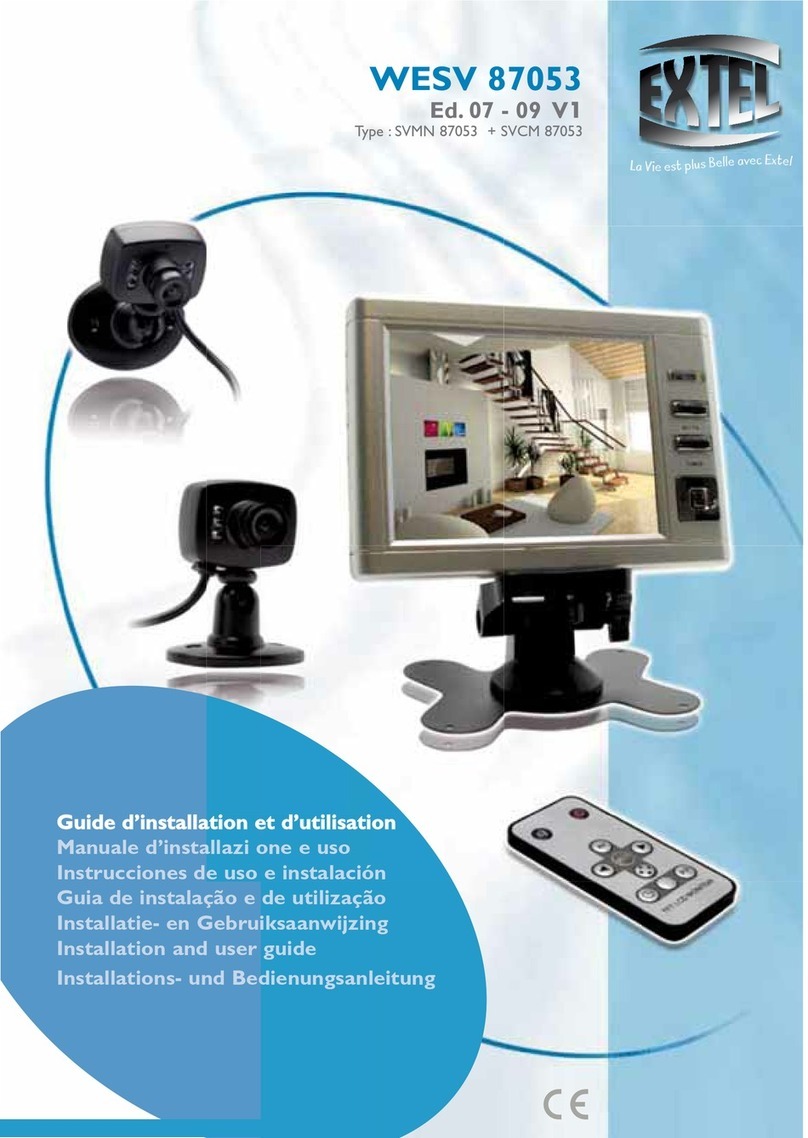
Extel
Extel WESV 87053 Installation and user guide

Scorpio
Scorpio CYL-200 Installation manual and user's guide
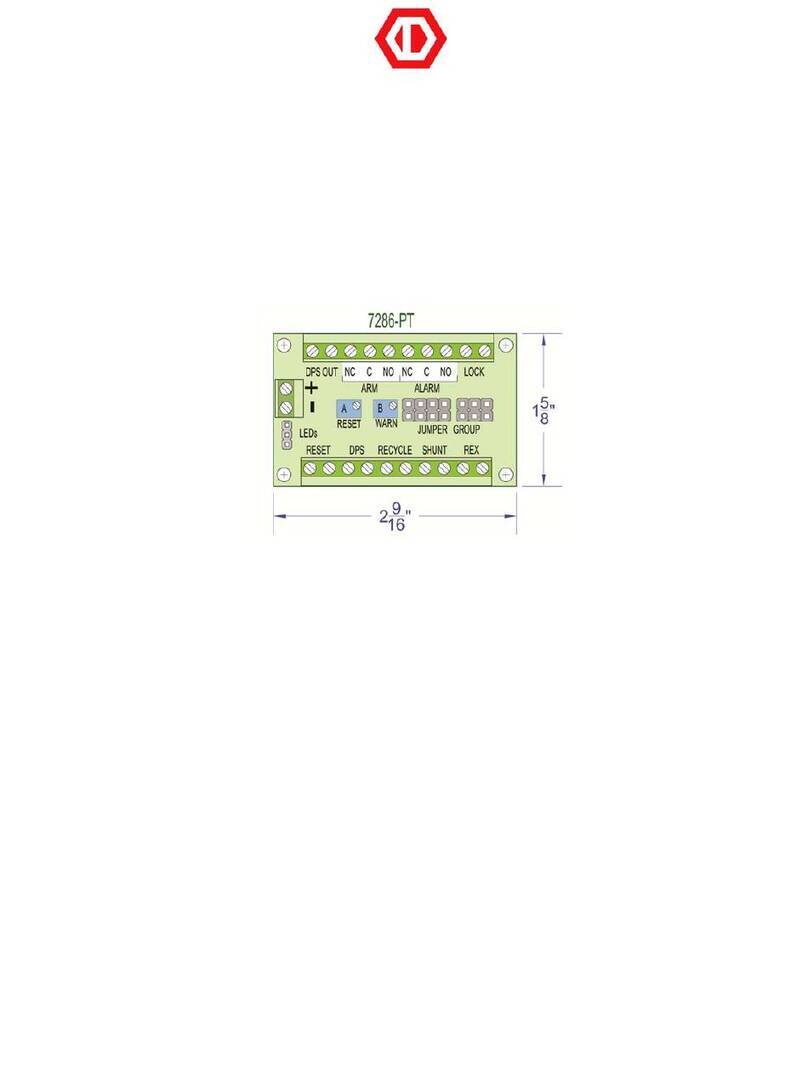
DORTRONICS SYSTEMS
DORTRONICS SYSTEMS 7286 Series user manual
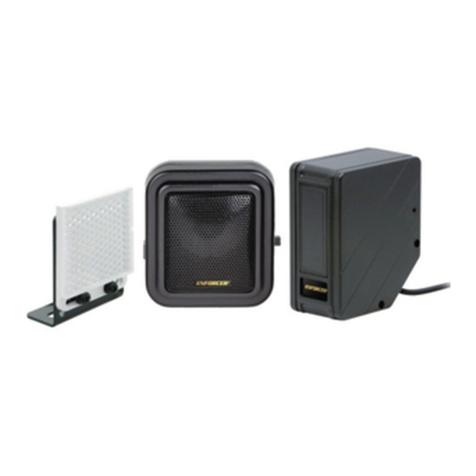
SECO-LARM
SECO-LARM ENFORCER E-931CS22RFCQ installation manual
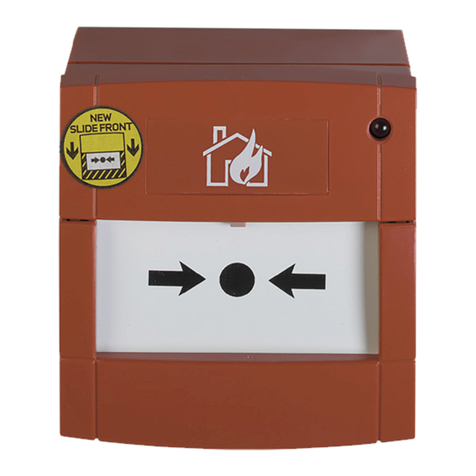
Kilsen
Kilsen KAL455 Installation sheet
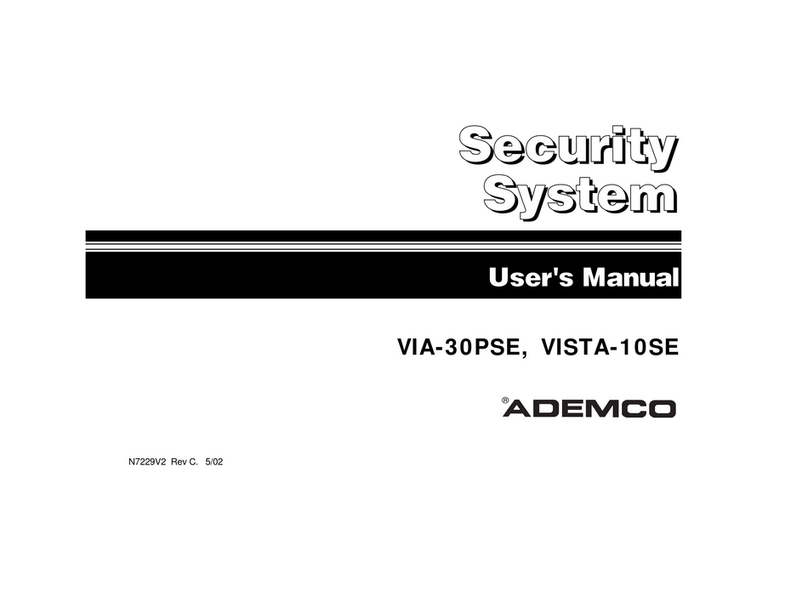
ADEMCO
ADEMCO Security System VISTA-10SE user manual
